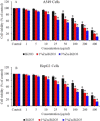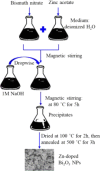Facile Synthesis of Zn-Doped Bi2O3 Nanoparticles and Their Selective Cytotoxicity toward Cancer Cells
- PMID: 34278121
- PMCID: PMC8280700
- DOI: 10.1021/acsomega.1c01467
Facile Synthesis of Zn-Doped Bi2O3 Nanoparticles and Their Selective Cytotoxicity toward Cancer Cells
Abstract
Bismuth (III) oxide nanoparticles (Bi2O3 NPs) have shown great potential for biomedical applications because of their tunable physicochemical properties. In this work, pure and Zn-doped (1 and 3 mol %) Bi2O3 NPs were synthesized by a facile chemical route and their cytotoxicity was examined in cancer cells and normal cells. The X-ray diffraction results show that the tetragonal phase of β-Bi2O3 remains unchanged after Zn-doping. Transmission electron microscopy and scanning electron microscopy images depicted that prepared particles were spherical with smooth surfaces and the homogeneous distribution of Zn in Bi2O3 with high-quality lattice fringes without distortion. Photoluminescence spectra revealed that intensity of Bi2O3 NPs decreases with increasing level of Zn-doping. Biological data showed that Zn-doped Bi2O3 NPs induce higher cytotoxicity to human lung (A549) and liver (HepG2) cancer cells as compared to pure Bi2O3 NPs, and cytotoxic intensity increases with increasing concentration of Zn-doping. Mechanistic data indicated that Zn-doped Bi2O3 NPs induce cytotoxicity in both types of cancer cells through the generation of reactive oxygen species and caspase-3 activation. On the other hand, biocompatibility of Zn-doped Bi2O3 NPs in normal cells (primary rat hepatocytes) was greater than that of pure Bi2O3 NPs and biocompatibility improves with increasing level of Zn-doping. Altogether, this is the first report highlighting the role of Zn-doping in the anticancer activity of Bi2O3 NPs. This study warrants further research on the antitumor activity of Zn-doped Bi2O3 NPs in suitable in vivo models.
© 2021 The Authors. Published by American Chemical Society.
Conflict of interest statement
The authors declare no competing financial interest.
Figures











References
LinkOut - more resources
Full Text Sources
